A Study on the Impact of FDI and Trade on India's Economic Growth
VerifiedAdded on 2022/12/26
|57
|21233
|1
Project
AI Summary
This project investigates the impact of Foreign Direct Investment (FDI) and international trade on the economic growth of India. The study employs a qualitative research approach, utilizing the positivism research philosophy, a deductive research approach, and a descriptive research design. Primary data was collected through interviews with managers from Tata Consultancy Services and Flipkart, India. The findings reveal a positive correlation between FDI, favorable trade policies, and economic expansion across various sectors in India. The research highlights how government policies, including FDI norms and business regulations, have attracted significant investments, boosting trade and contributing to economic growth. The study also offers recommendations for attracting more FDI, such as enhancing India's international business image and formulating supportive trade policies. The project provides a detailed analysis of the current economic landscape, the influence of FDI, and the role of trade in fostering growth within the Indian context.
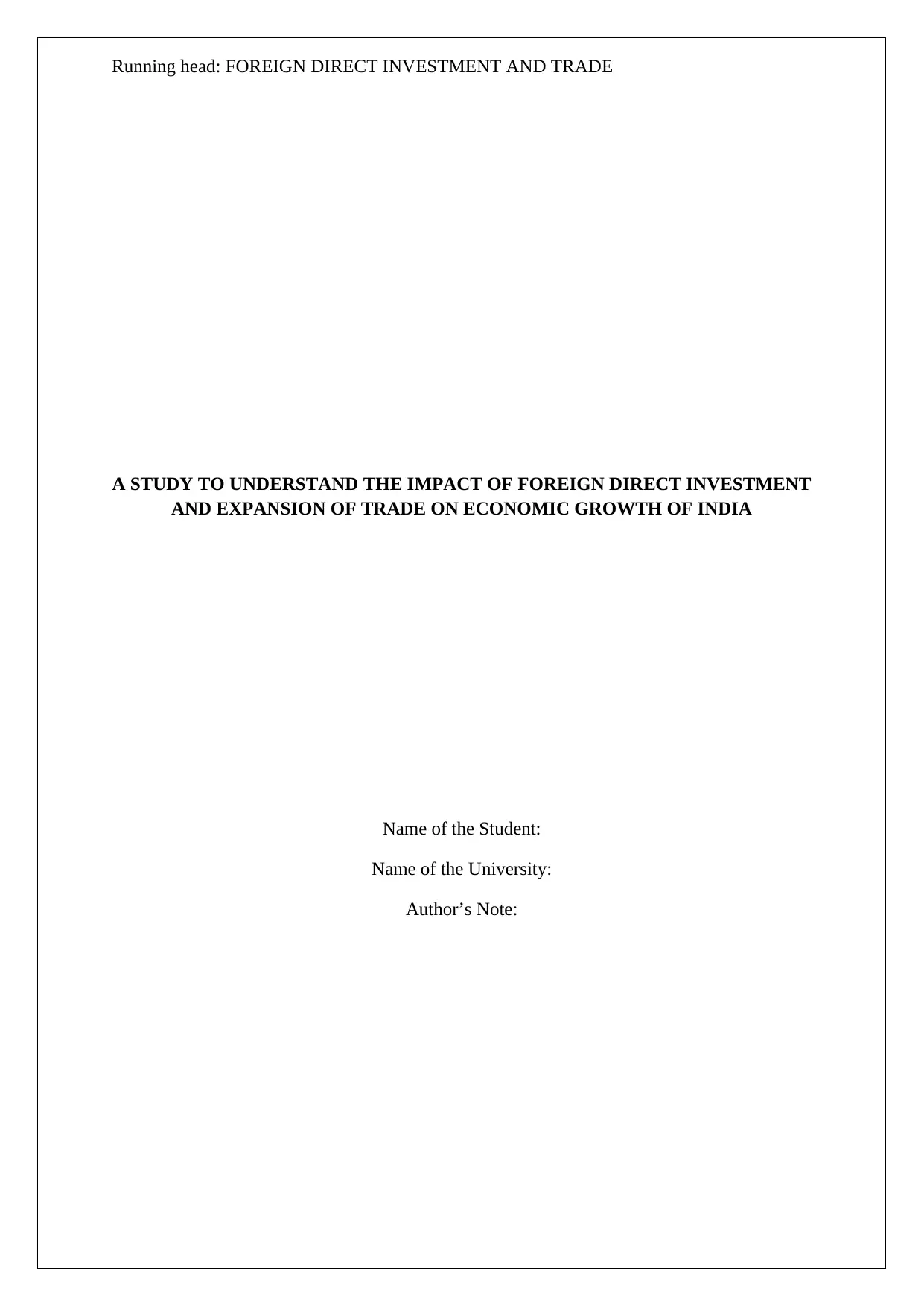
Running head: FOREIGN DIRECT INVESTMENT AND TRADE
A STUDY TO UNDERSTAND THE IMPACT OF FOREIGN DIRECT INVESTMENT
AND EXPANSION OF TRADE ON ECONOMIC GROWTH OF INDIA
Name of the Student:
Name of the University:
Author’s Note:
A STUDY TO UNDERSTAND THE IMPACT OF FOREIGN DIRECT INVESTMENT
AND EXPANSION OF TRADE ON ECONOMIC GROWTH OF INDIA
Name of the Student:
Name of the University:
Author’s Note:
Paraphrase This Document
Need a fresh take? Get an instant paraphrase of this document with our AI Paraphraser
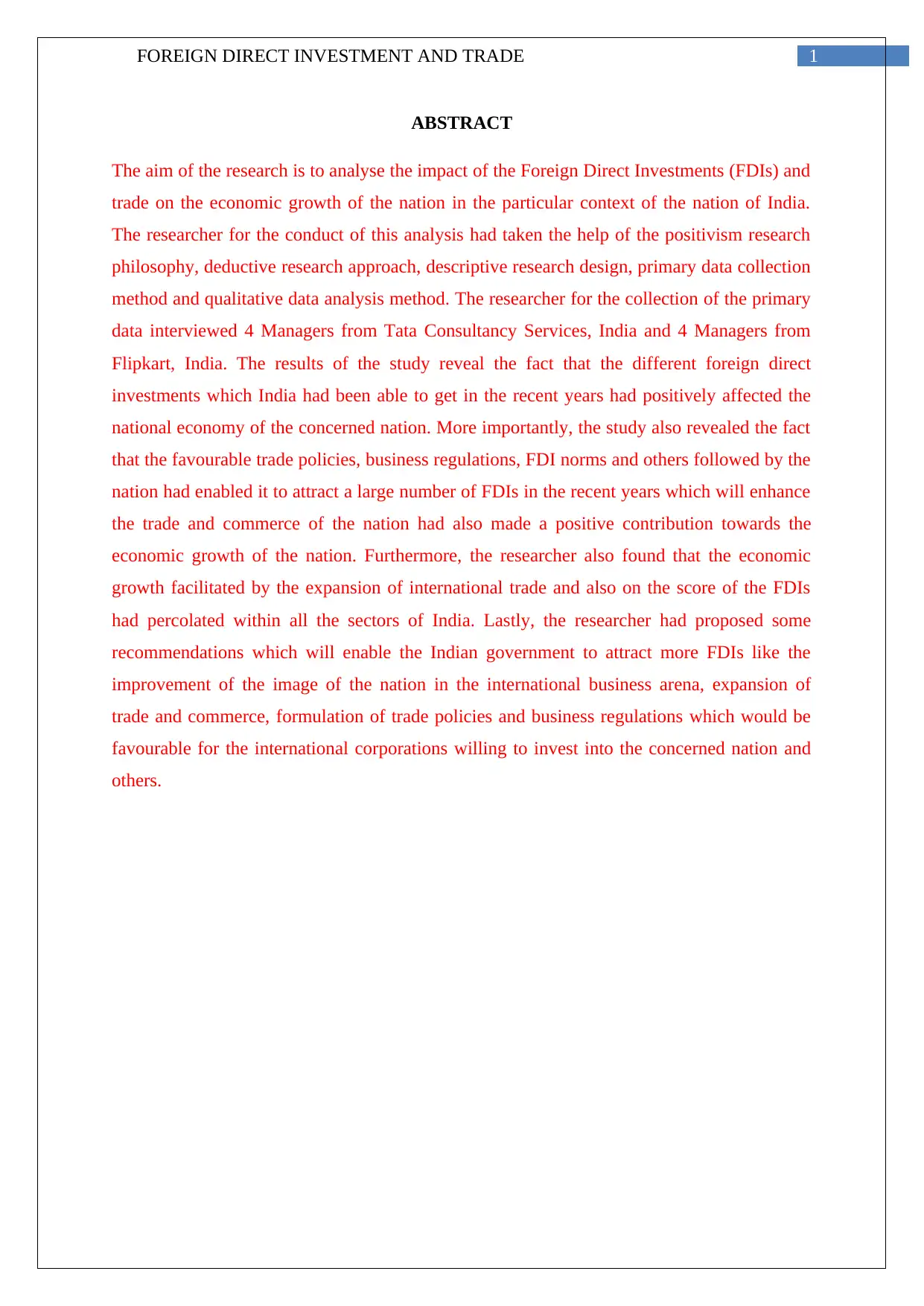
1FOREIGN DIRECT INVESTMENT AND TRADE
ABSTRACT
The aim of the research is to analyse the impact of the Foreign Direct Investments (FDIs) and
trade on the economic growth of the nation in the particular context of the nation of India.
The researcher for the conduct of this analysis had taken the help of the positivism research
philosophy, deductive research approach, descriptive research design, primary data collection
method and qualitative data analysis method. The researcher for the collection of the primary
data interviewed 4 Managers from Tata Consultancy Services, India and 4 Managers from
Flipkart, India. The results of the study reveal the fact that the different foreign direct
investments which India had been able to get in the recent years had positively affected the
national economy of the concerned nation. More importantly, the study also revealed the fact
that the favourable trade policies, business regulations, FDI norms and others followed by the
nation had enabled it to attract a large number of FDIs in the recent years which will enhance
the trade and commerce of the nation had also made a positive contribution towards the
economic growth of the nation. Furthermore, the researcher also found that the economic
growth facilitated by the expansion of international trade and also on the score of the FDIs
had percolated within all the sectors of India. Lastly, the researcher had proposed some
recommendations which will enable the Indian government to attract more FDIs like the
improvement of the image of the nation in the international business arena, expansion of
trade and commerce, formulation of trade policies and business regulations which would be
favourable for the international corporations willing to invest into the concerned nation and
others.
ABSTRACT
The aim of the research is to analyse the impact of the Foreign Direct Investments (FDIs) and
trade on the economic growth of the nation in the particular context of the nation of India.
The researcher for the conduct of this analysis had taken the help of the positivism research
philosophy, deductive research approach, descriptive research design, primary data collection
method and qualitative data analysis method. The researcher for the collection of the primary
data interviewed 4 Managers from Tata Consultancy Services, India and 4 Managers from
Flipkart, India. The results of the study reveal the fact that the different foreign direct
investments which India had been able to get in the recent years had positively affected the
national economy of the concerned nation. More importantly, the study also revealed the fact
that the favourable trade policies, business regulations, FDI norms and others followed by the
nation had enabled it to attract a large number of FDIs in the recent years which will enhance
the trade and commerce of the nation had also made a positive contribution towards the
economic growth of the nation. Furthermore, the researcher also found that the economic
growth facilitated by the expansion of international trade and also on the score of the FDIs
had percolated within all the sectors of India. Lastly, the researcher had proposed some
recommendations which will enable the Indian government to attract more FDIs like the
improvement of the image of the nation in the international business arena, expansion of
trade and commerce, formulation of trade policies and business regulations which would be
favourable for the international corporations willing to invest into the concerned nation and
others.
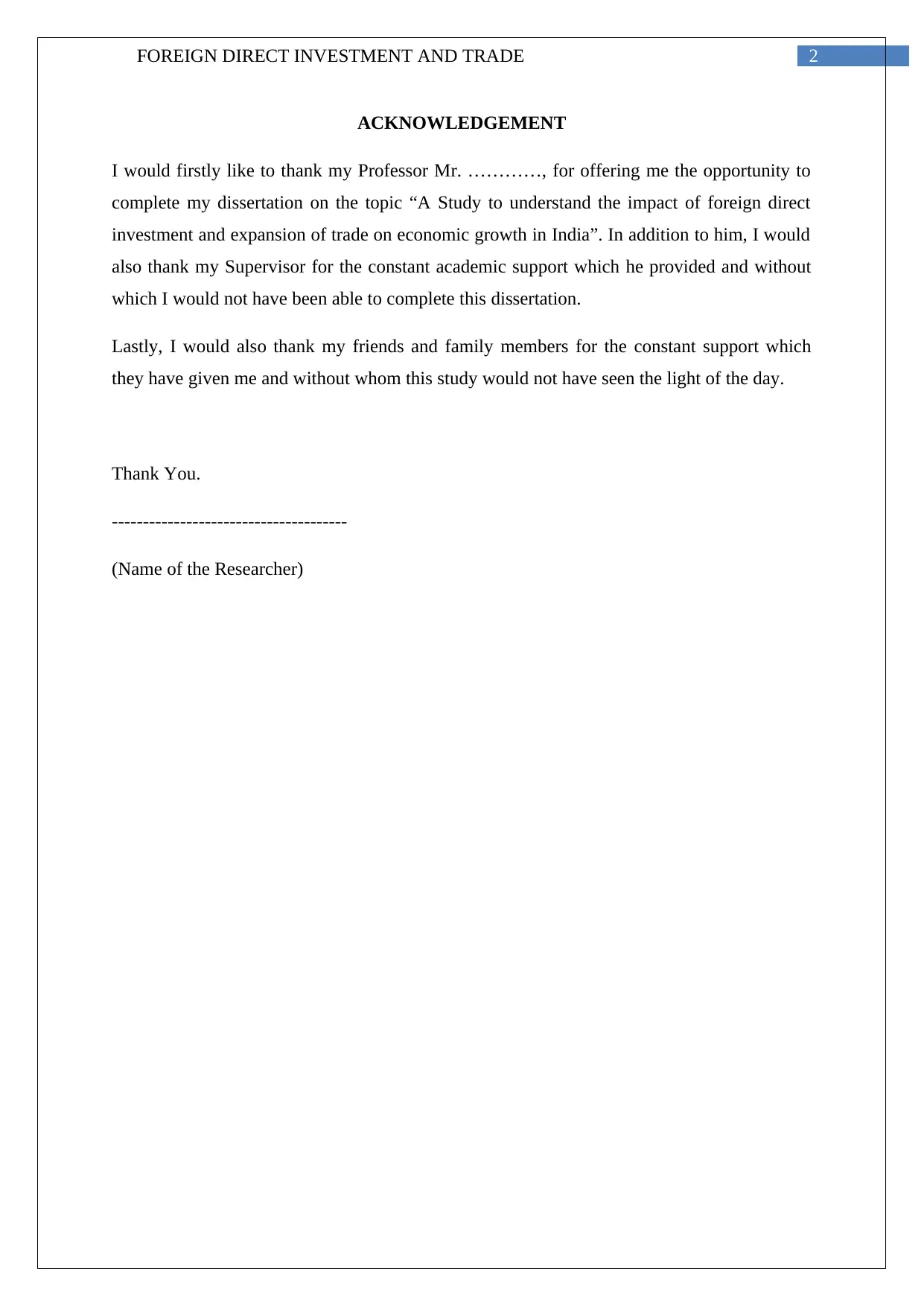
2FOREIGN DIRECT INVESTMENT AND TRADE
ACKNOWLEDGEMENT
I would firstly like to thank my Professor Mr. …………, for offering me the opportunity to
complete my dissertation on the topic “A Study to understand the impact of foreign direct
investment and expansion of trade on economic growth in India”. In addition to him, I would
also thank my Supervisor for the constant academic support which he provided and without
which I would not have been able to complete this dissertation.
Lastly, I would also thank my friends and family members for the constant support which
they have given me and without whom this study would not have seen the light of the day.
Thank You.
--------------------------------------
(Name of the Researcher)
ACKNOWLEDGEMENT
I would firstly like to thank my Professor Mr. …………, for offering me the opportunity to
complete my dissertation on the topic “A Study to understand the impact of foreign direct
investment and expansion of trade on economic growth in India”. In addition to him, I would
also thank my Supervisor for the constant academic support which he provided and without
which I would not have been able to complete this dissertation.
Lastly, I would also thank my friends and family members for the constant support which
they have given me and without whom this study would not have seen the light of the day.
Thank You.
--------------------------------------
(Name of the Researcher)
⊘ This is a preview!⊘
Do you want full access?
Subscribe today to unlock all pages.

Trusted by 1+ million students worldwide
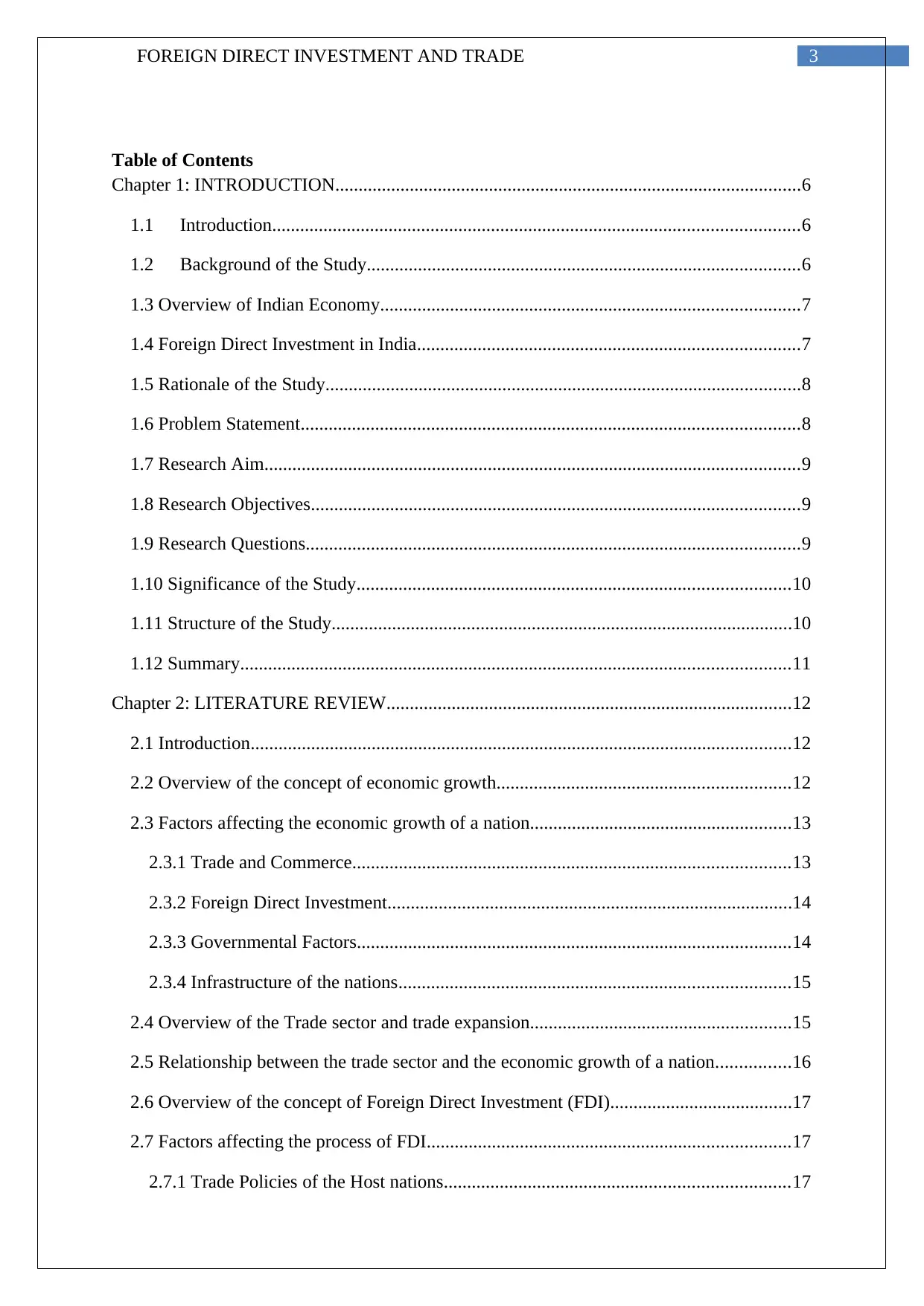
3FOREIGN DIRECT INVESTMENT AND TRADE
Table of Contents
Chapter 1: INTRODUCTION....................................................................................................6
1.1 Introduction.................................................................................................................6
1.2 Background of the Study.............................................................................................6
1.3 Overview of Indian Economy..........................................................................................7
1.4 Foreign Direct Investment in India..................................................................................7
1.5 Rationale of the Study......................................................................................................8
1.6 Problem Statement...........................................................................................................8
1.7 Research Aim...................................................................................................................9
1.8 Research Objectives.........................................................................................................9
1.9 Research Questions..........................................................................................................9
1.10 Significance of the Study.............................................................................................10
1.11 Structure of the Study...................................................................................................10
1.12 Summary......................................................................................................................11
Chapter 2: LITERATURE REVIEW.......................................................................................12
2.1 Introduction....................................................................................................................12
2.2 Overview of the concept of economic growth...............................................................12
2.3 Factors affecting the economic growth of a nation........................................................13
2.3.1 Trade and Commerce..............................................................................................13
2.3.2 Foreign Direct Investment.......................................................................................14
2.3.3 Governmental Factors.............................................................................................14
2.3.4 Infrastructure of the nations....................................................................................15
2.4 Overview of the Trade sector and trade expansion........................................................15
2.5 Relationship between the trade sector and the economic growth of a nation................16
2.6 Overview of the concept of Foreign Direct Investment (FDI).......................................17
2.7 Factors affecting the process of FDI..............................................................................17
2.7.1 Trade Policies of the Host nations..........................................................................17
Table of Contents
Chapter 1: INTRODUCTION....................................................................................................6
1.1 Introduction.................................................................................................................6
1.2 Background of the Study.............................................................................................6
1.3 Overview of Indian Economy..........................................................................................7
1.4 Foreign Direct Investment in India..................................................................................7
1.5 Rationale of the Study......................................................................................................8
1.6 Problem Statement...........................................................................................................8
1.7 Research Aim...................................................................................................................9
1.8 Research Objectives.........................................................................................................9
1.9 Research Questions..........................................................................................................9
1.10 Significance of the Study.............................................................................................10
1.11 Structure of the Study...................................................................................................10
1.12 Summary......................................................................................................................11
Chapter 2: LITERATURE REVIEW.......................................................................................12
2.1 Introduction....................................................................................................................12
2.2 Overview of the concept of economic growth...............................................................12
2.3 Factors affecting the economic growth of a nation........................................................13
2.3.1 Trade and Commerce..............................................................................................13
2.3.2 Foreign Direct Investment.......................................................................................14
2.3.3 Governmental Factors.............................................................................................14
2.3.4 Infrastructure of the nations....................................................................................15
2.4 Overview of the Trade sector and trade expansion........................................................15
2.5 Relationship between the trade sector and the economic growth of a nation................16
2.6 Overview of the concept of Foreign Direct Investment (FDI).......................................17
2.7 Factors affecting the process of FDI..............................................................................17
2.7.1 Trade Policies of the Host nations..........................................................................17
Paraphrase This Document
Need a fresh take? Get an instant paraphrase of this document with our AI Paraphraser
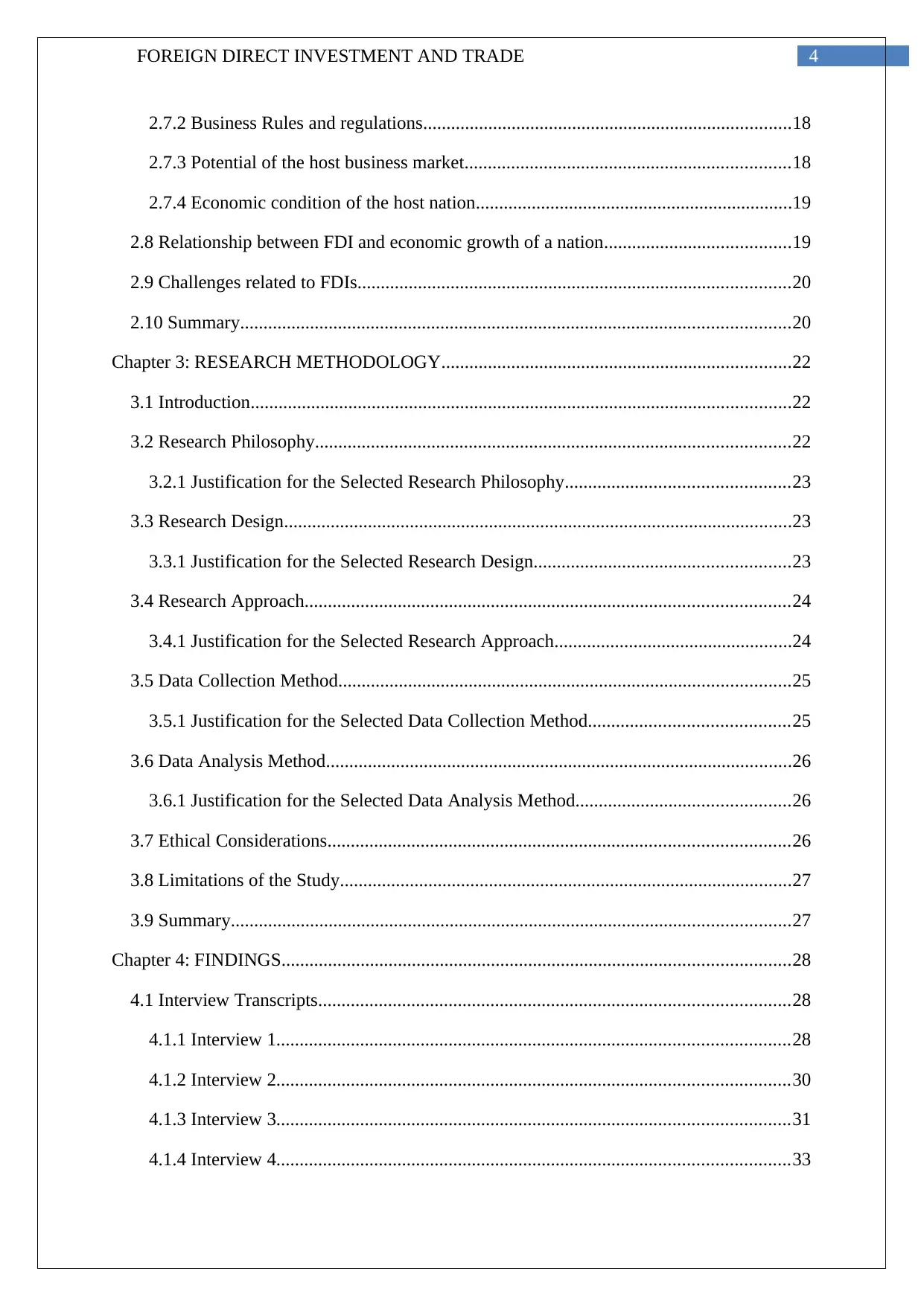
4FOREIGN DIRECT INVESTMENT AND TRADE
2.7.2 Business Rules and regulations...............................................................................18
2.7.3 Potential of the host business market......................................................................18
2.7.4 Economic condition of the host nation....................................................................19
2.8 Relationship between FDI and economic growth of a nation........................................19
2.9 Challenges related to FDIs.............................................................................................20
2.10 Summary......................................................................................................................20
Chapter 3: RESEARCH METHODOLOGY...........................................................................22
3.1 Introduction....................................................................................................................22
3.2 Research Philosophy......................................................................................................22
3.2.1 Justification for the Selected Research Philosophy................................................23
3.3 Research Design.............................................................................................................23
3.3.1 Justification for the Selected Research Design.......................................................23
3.4 Research Approach........................................................................................................24
3.4.1 Justification for the Selected Research Approach...................................................24
3.5 Data Collection Method.................................................................................................25
3.5.1 Justification for the Selected Data Collection Method...........................................25
3.6 Data Analysis Method....................................................................................................26
3.6.1 Justification for the Selected Data Analysis Method..............................................26
3.7 Ethical Considerations...................................................................................................26
3.8 Limitations of the Study.................................................................................................27
3.9 Summary........................................................................................................................27
Chapter 4: FINDINGS.............................................................................................................28
4.1 Interview Transcripts.....................................................................................................28
4.1.1 Interview 1..............................................................................................................28
4.1.2 Interview 2..............................................................................................................30
4.1.3 Interview 3..............................................................................................................31
4.1.4 Interview 4..............................................................................................................33
2.7.2 Business Rules and regulations...............................................................................18
2.7.3 Potential of the host business market......................................................................18
2.7.4 Economic condition of the host nation....................................................................19
2.8 Relationship between FDI and economic growth of a nation........................................19
2.9 Challenges related to FDIs.............................................................................................20
2.10 Summary......................................................................................................................20
Chapter 3: RESEARCH METHODOLOGY...........................................................................22
3.1 Introduction....................................................................................................................22
3.2 Research Philosophy......................................................................................................22
3.2.1 Justification for the Selected Research Philosophy................................................23
3.3 Research Design.............................................................................................................23
3.3.1 Justification for the Selected Research Design.......................................................23
3.4 Research Approach........................................................................................................24
3.4.1 Justification for the Selected Research Approach...................................................24
3.5 Data Collection Method.................................................................................................25
3.5.1 Justification for the Selected Data Collection Method...........................................25
3.6 Data Analysis Method....................................................................................................26
3.6.1 Justification for the Selected Data Analysis Method..............................................26
3.7 Ethical Considerations...................................................................................................26
3.8 Limitations of the Study.................................................................................................27
3.9 Summary........................................................................................................................27
Chapter 4: FINDINGS.............................................................................................................28
4.1 Interview Transcripts.....................................................................................................28
4.1.1 Interview 1..............................................................................................................28
4.1.2 Interview 2..............................................................................................................30
4.1.3 Interview 3..............................................................................................................31
4.1.4 Interview 4..............................................................................................................33
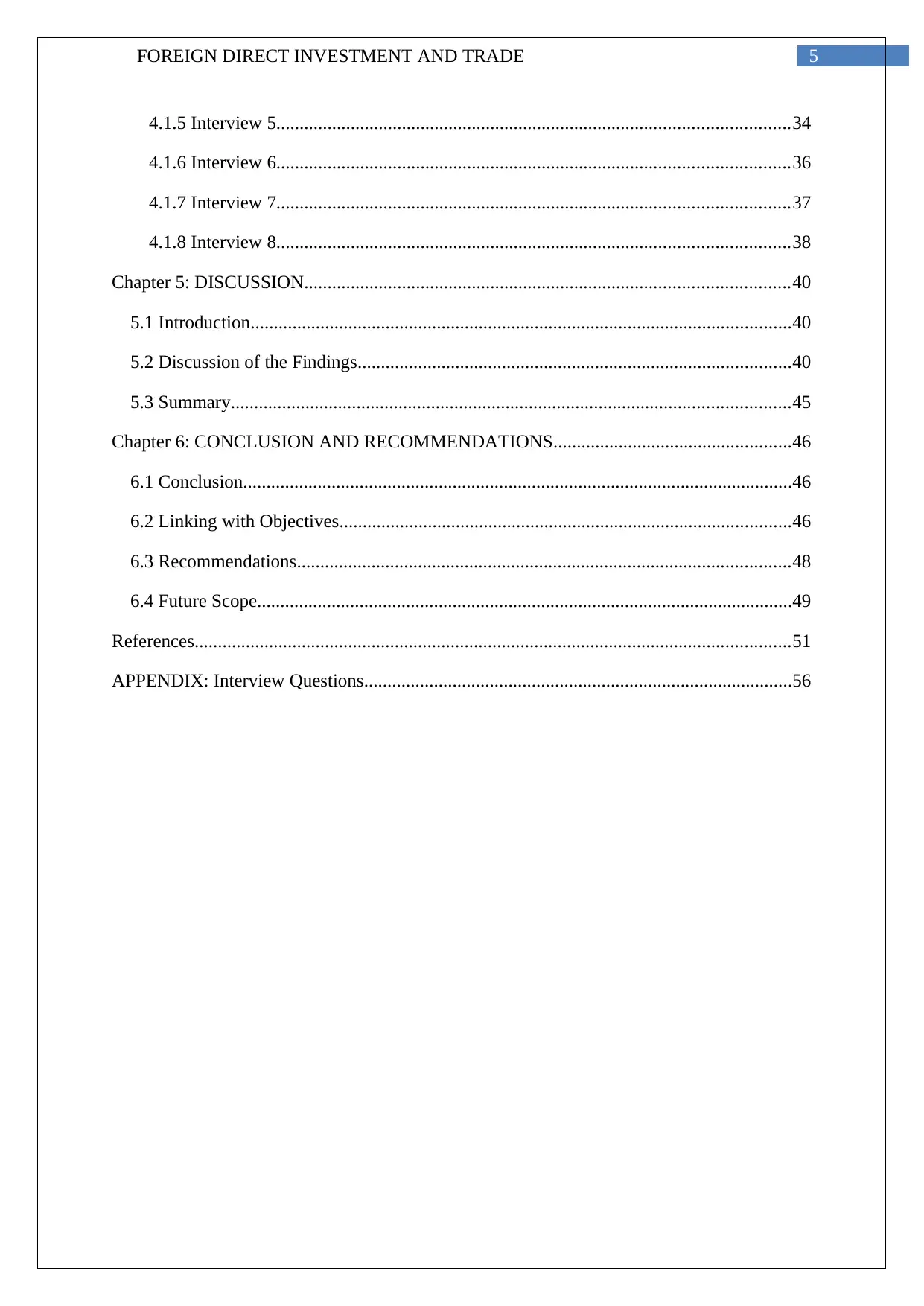
5FOREIGN DIRECT INVESTMENT AND TRADE
4.1.5 Interview 5..............................................................................................................34
4.1.6 Interview 6..............................................................................................................36
4.1.7 Interview 7..............................................................................................................37
4.1.8 Interview 8..............................................................................................................38
Chapter 5: DISCUSSION........................................................................................................40
5.1 Introduction....................................................................................................................40
5.2 Discussion of the Findings.............................................................................................40
5.3 Summary........................................................................................................................45
Chapter 6: CONCLUSION AND RECOMMENDATIONS...................................................46
6.1 Conclusion......................................................................................................................46
6.2 Linking with Objectives.................................................................................................46
6.3 Recommendations..........................................................................................................48
6.4 Future Scope...................................................................................................................49
References................................................................................................................................51
APPENDIX: Interview Questions............................................................................................56
4.1.5 Interview 5..............................................................................................................34
4.1.6 Interview 6..............................................................................................................36
4.1.7 Interview 7..............................................................................................................37
4.1.8 Interview 8..............................................................................................................38
Chapter 5: DISCUSSION........................................................................................................40
5.1 Introduction....................................................................................................................40
5.2 Discussion of the Findings.............................................................................................40
5.3 Summary........................................................................................................................45
Chapter 6: CONCLUSION AND RECOMMENDATIONS...................................................46
6.1 Conclusion......................................................................................................................46
6.2 Linking with Objectives.................................................................................................46
6.3 Recommendations..........................................................................................................48
6.4 Future Scope...................................................................................................................49
References................................................................................................................................51
APPENDIX: Interview Questions............................................................................................56
⊘ This is a preview!⊘
Do you want full access?
Subscribe today to unlock all pages.

Trusted by 1+ million students worldwide
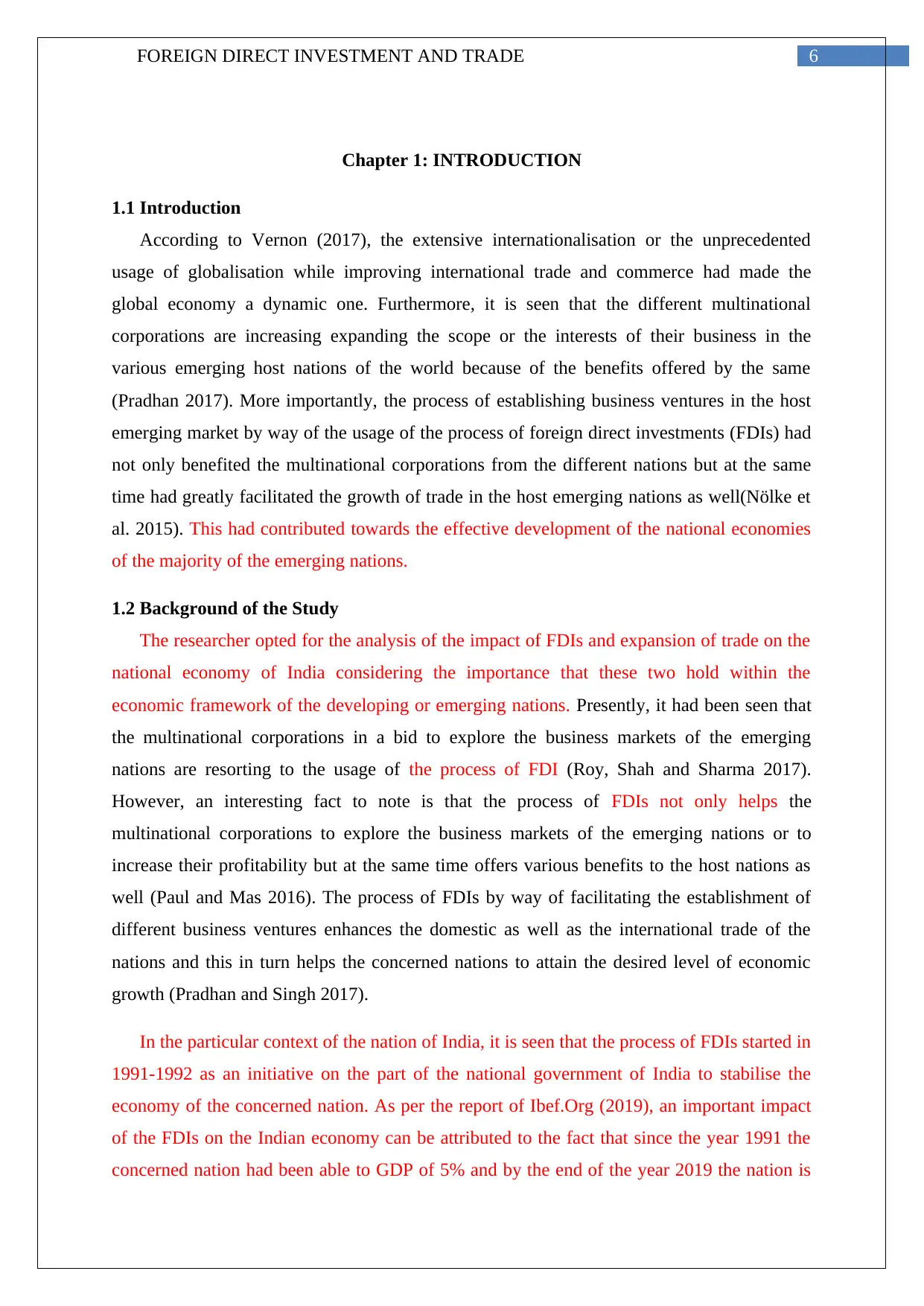
6FOREIGN DIRECT INVESTMENT AND TRADE
Chapter 1: INTRODUCTION
1.1 Introduction
According to Vernon (2017), the extensive internationalisation or the unprecedented
usage of globalisation while improving international trade and commerce had made the
global economy a dynamic one. Furthermore, it is seen that the different multinational
corporations are increasing expanding the scope or the interests of their business in the
various emerging host nations of the world because of the benefits offered by the same
(Pradhan 2017). More importantly, the process of establishing business ventures in the host
emerging market by way of the usage of the process of foreign direct investments (FDIs) had
not only benefited the multinational corporations from the different nations but at the same
time had greatly facilitated the growth of trade in the host emerging nations as well(Nölke et
al. 2015). This had contributed towards the effective development of the national economies
of the majority of the emerging nations.
1.2 Background of the Study
The researcher opted for the analysis of the impact of FDIs and expansion of trade on the
national economy of India considering the importance that these two hold within the
economic framework of the developing or emerging nations. Presently, it had been seen that
the multinational corporations in a bid to explore the business markets of the emerging
nations are resorting to the usage of the process of FDI (Roy, Shah and Sharma 2017).
However, an interesting fact to note is that the process of FDIs not only helps the
multinational corporations to explore the business markets of the emerging nations or to
increase their profitability but at the same time offers various benefits to the host nations as
well (Paul and Mas 2016). The process of FDIs by way of facilitating the establishment of
different business ventures enhances the domestic as well as the international trade of the
nations and this in turn helps the concerned nations to attain the desired level of economic
growth (Pradhan and Singh 2017).
In the particular context of the nation of India, it is seen that the process of FDIs started in
1991-1992 as an initiative on the part of the national government of India to stabilise the
economy of the concerned nation. As per the report of Ibef.Org (2019), an important impact
of the FDIs on the Indian economy can be attributed to the fact that since the year 1991 the
concerned nation had been able to GDP of 5% and by the end of the year 2019 the nation is
Chapter 1: INTRODUCTION
1.1 Introduction
According to Vernon (2017), the extensive internationalisation or the unprecedented
usage of globalisation while improving international trade and commerce had made the
global economy a dynamic one. Furthermore, it is seen that the different multinational
corporations are increasing expanding the scope or the interests of their business in the
various emerging host nations of the world because of the benefits offered by the same
(Pradhan 2017). More importantly, the process of establishing business ventures in the host
emerging market by way of the usage of the process of foreign direct investments (FDIs) had
not only benefited the multinational corporations from the different nations but at the same
time had greatly facilitated the growth of trade in the host emerging nations as well(Nölke et
al. 2015). This had contributed towards the effective development of the national economies
of the majority of the emerging nations.
1.2 Background of the Study
The researcher opted for the analysis of the impact of FDIs and expansion of trade on the
national economy of India considering the importance that these two hold within the
economic framework of the developing or emerging nations. Presently, it had been seen that
the multinational corporations in a bid to explore the business markets of the emerging
nations are resorting to the usage of the process of FDI (Roy, Shah and Sharma 2017).
However, an interesting fact to note is that the process of FDIs not only helps the
multinational corporations to explore the business markets of the emerging nations or to
increase their profitability but at the same time offers various benefits to the host nations as
well (Paul and Mas 2016). The process of FDIs by way of facilitating the establishment of
different business ventures enhances the domestic as well as the international trade of the
nations and this in turn helps the concerned nations to attain the desired level of economic
growth (Pradhan and Singh 2017).
In the particular context of the nation of India, it is seen that the process of FDIs started in
1991-1992 as an initiative on the part of the national government of India to stabilise the
economy of the concerned nation. As per the report of Ibef.Org (2019), an important impact
of the FDIs on the Indian economy can be attributed to the fact that since the year 1991 the
concerned nation had been able to GDP of 5% and by the end of the year 2019 the nation is
Paraphrase This Document
Need a fresh take? Get an instant paraphrase of this document with our AI Paraphraser
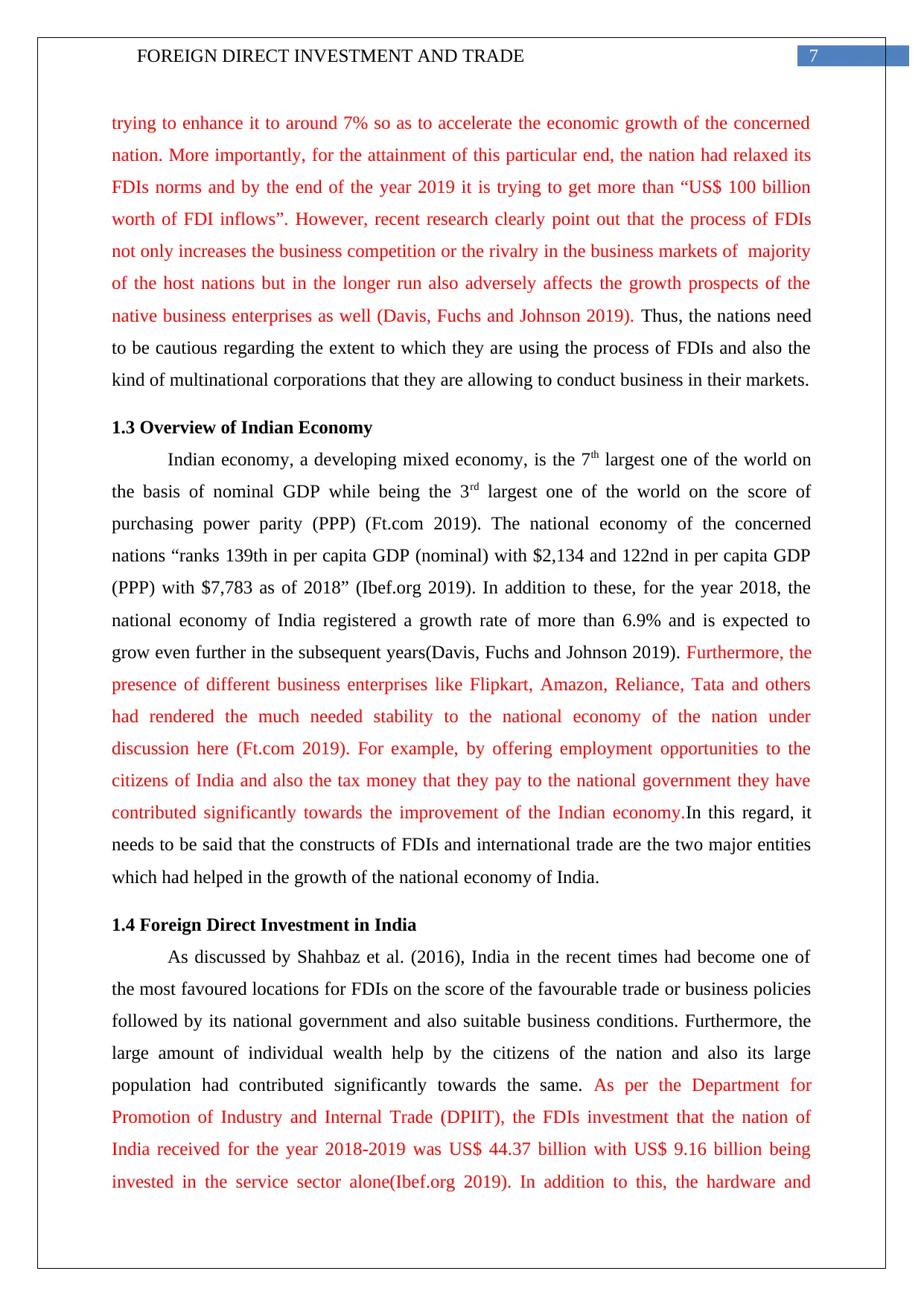
7FOREIGN DIRECT INVESTMENT AND TRADE
trying to enhance it to around 7% so as to accelerate the economic growth of the concerned
nation. More importantly, for the attainment of this particular end, the nation had relaxed its
FDIs norms and by the end of the year 2019 it is trying to get more than “US$ 100 billion
worth of FDI inflows”. However, recent research clearly point out that the process of FDIs
not only increases the business competition or the rivalry in the business markets of majority
of the host nations but in the longer run also adversely affects the growth prospects of the
native business enterprises as well (Davis, Fuchs and Johnson 2019). Thus, the nations need
to be cautious regarding the extent to which they are using the process of FDIs and also the
kind of multinational corporations that they are allowing to conduct business in their markets.
1.3 Overview of Indian Economy
Indian economy, a developing mixed economy, is the 7th largest one of the world on
the basis of nominal GDP while being the 3rd largest one of the world on the score of
purchasing power parity (PPP) (Ft.com 2019). The national economy of the concerned
nations “ranks 139th in per capita GDP (nominal) with $2,134 and 122nd in per capita GDP
(PPP) with $7,783 as of 2018” (Ibef.org 2019). In addition to these, for the year 2018, the
national economy of India registered a growth rate of more than 6.9% and is expected to
grow even further in the subsequent years(Davis, Fuchs and Johnson 2019). Furthermore, the
presence of different business enterprises like Flipkart, Amazon, Reliance, Tata and others
had rendered the much needed stability to the national economy of the nation under
discussion here (Ft.com 2019). For example, by offering employment opportunities to the
citizens of India and also the tax money that they pay to the national government they have
contributed significantly towards the improvement of the Indian economy.In this regard, it
needs to be said that the constructs of FDIs and international trade are the two major entities
which had helped in the growth of the national economy of India.
1.4 Foreign Direct Investment in India
As discussed by Shahbaz et al. (2016), India in the recent times had become one of
the most favoured locations for FDIs on the score of the favourable trade or business policies
followed by its national government and also suitable business conditions. Furthermore, the
large amount of individual wealth help by the citizens of the nation and also its large
population had contributed significantly towards the same. As per the Department for
Promotion of Industry and Internal Trade (DPIIT), the FDIs investment that the nation of
India received for the year 2018-2019 was US$ 44.37 billion with US$ 9.16 billion being
invested in the service sector alone(Ibef.org 2019). In addition to this, the hardware and
trying to enhance it to around 7% so as to accelerate the economic growth of the concerned
nation. More importantly, for the attainment of this particular end, the nation had relaxed its
FDIs norms and by the end of the year 2019 it is trying to get more than “US$ 100 billion
worth of FDI inflows”. However, recent research clearly point out that the process of FDIs
not only increases the business competition or the rivalry in the business markets of majority
of the host nations but in the longer run also adversely affects the growth prospects of the
native business enterprises as well (Davis, Fuchs and Johnson 2019). Thus, the nations need
to be cautious regarding the extent to which they are using the process of FDIs and also the
kind of multinational corporations that they are allowing to conduct business in their markets.
1.3 Overview of Indian Economy
Indian economy, a developing mixed economy, is the 7th largest one of the world on
the basis of nominal GDP while being the 3rd largest one of the world on the score of
purchasing power parity (PPP) (Ft.com 2019). The national economy of the concerned
nations “ranks 139th in per capita GDP (nominal) with $2,134 and 122nd in per capita GDP
(PPP) with $7,783 as of 2018” (Ibef.org 2019). In addition to these, for the year 2018, the
national economy of India registered a growth rate of more than 6.9% and is expected to
grow even further in the subsequent years(Davis, Fuchs and Johnson 2019). Furthermore, the
presence of different business enterprises like Flipkart, Amazon, Reliance, Tata and others
had rendered the much needed stability to the national economy of the nation under
discussion here (Ft.com 2019). For example, by offering employment opportunities to the
citizens of India and also the tax money that they pay to the national government they have
contributed significantly towards the improvement of the Indian economy.In this regard, it
needs to be said that the constructs of FDIs and international trade are the two major entities
which had helped in the growth of the national economy of India.
1.4 Foreign Direct Investment in India
As discussed by Shahbaz et al. (2016), India in the recent times had become one of
the most favoured locations for FDIs on the score of the favourable trade or business policies
followed by its national government and also suitable business conditions. Furthermore, the
large amount of individual wealth help by the citizens of the nation and also its large
population had contributed significantly towards the same. As per the Department for
Promotion of Industry and Internal Trade (DPIIT), the FDIs investment that the nation of
India received for the year 2018-2019 was US$ 44.37 billion with US$ 9.16 billion being
invested in the service sector alone(Ibef.org 2019). In addition to this, the hardware and
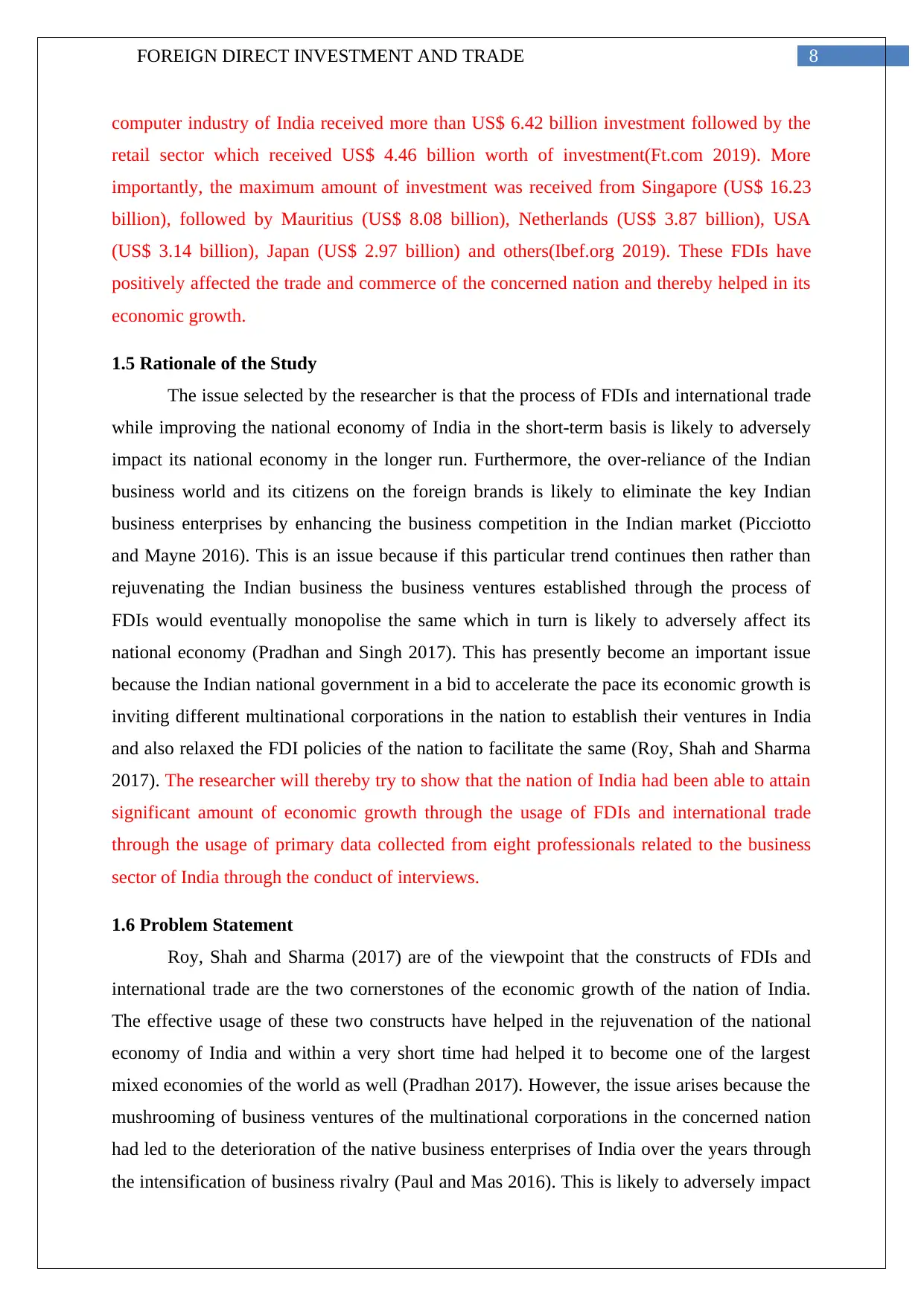
8FOREIGN DIRECT INVESTMENT AND TRADE
computer industry of India received more than US$ 6.42 billion investment followed by the
retail sector which received US$ 4.46 billion worth of investment(Ft.com 2019). More
importantly, the maximum amount of investment was received from Singapore (US$ 16.23
billion), followed by Mauritius (US$ 8.08 billion), Netherlands (US$ 3.87 billion), USA
(US$ 3.14 billion), Japan (US$ 2.97 billion) and others(Ibef.org 2019). These FDIs have
positively affected the trade and commerce of the concerned nation and thereby helped in its
economic growth.
1.5 Rationale of the Study
The issue selected by the researcher is that the process of FDIs and international trade
while improving the national economy of India in the short-term basis is likely to adversely
impact its national economy in the longer run. Furthermore, the over-reliance of the Indian
business world and its citizens on the foreign brands is likely to eliminate the key Indian
business enterprises by enhancing the business competition in the Indian market (Picciotto
and Mayne 2016). This is an issue because if this particular trend continues then rather than
rejuvenating the Indian business the business ventures established through the process of
FDIs would eventually monopolise the same which in turn is likely to adversely affect its
national economy (Pradhan and Singh 2017). This has presently become an important issue
because the Indian national government in a bid to accelerate the pace its economic growth is
inviting different multinational corporations in the nation to establish their ventures in India
and also relaxed the FDI policies of the nation to facilitate the same (Roy, Shah and Sharma
2017). The researcher will thereby try to show that the nation of India had been able to attain
significant amount of economic growth through the usage of FDIs and international trade
through the usage of primary data collected from eight professionals related to the business
sector of India through the conduct of interviews.
1.6 Problem Statement
Roy, Shah and Sharma (2017) are of the viewpoint that the constructs of FDIs and
international trade are the two cornerstones of the economic growth of the nation of India.
The effective usage of these two constructs have helped in the rejuvenation of the national
economy of India and within a very short time had helped it to become one of the largest
mixed economies of the world as well (Pradhan 2017). However, the issue arises because the
mushrooming of business ventures of the multinational corporations in the concerned nation
had led to the deterioration of the native business enterprises of India over the years through
the intensification of business rivalry (Paul and Mas 2016). This is likely to adversely impact
computer industry of India received more than US$ 6.42 billion investment followed by the
retail sector which received US$ 4.46 billion worth of investment(Ft.com 2019). More
importantly, the maximum amount of investment was received from Singapore (US$ 16.23
billion), followed by Mauritius (US$ 8.08 billion), Netherlands (US$ 3.87 billion), USA
(US$ 3.14 billion), Japan (US$ 2.97 billion) and others(Ibef.org 2019). These FDIs have
positively affected the trade and commerce of the concerned nation and thereby helped in its
economic growth.
1.5 Rationale of the Study
The issue selected by the researcher is that the process of FDIs and international trade
while improving the national economy of India in the short-term basis is likely to adversely
impact its national economy in the longer run. Furthermore, the over-reliance of the Indian
business world and its citizens on the foreign brands is likely to eliminate the key Indian
business enterprises by enhancing the business competition in the Indian market (Picciotto
and Mayne 2016). This is an issue because if this particular trend continues then rather than
rejuvenating the Indian business the business ventures established through the process of
FDIs would eventually monopolise the same which in turn is likely to adversely affect its
national economy (Pradhan and Singh 2017). This has presently become an important issue
because the Indian national government in a bid to accelerate the pace its economic growth is
inviting different multinational corporations in the nation to establish their ventures in India
and also relaxed the FDI policies of the nation to facilitate the same (Roy, Shah and Sharma
2017). The researcher will thereby try to show that the nation of India had been able to attain
significant amount of economic growth through the usage of FDIs and international trade
through the usage of primary data collected from eight professionals related to the business
sector of India through the conduct of interviews.
1.6 Problem Statement
Roy, Shah and Sharma (2017) are of the viewpoint that the constructs of FDIs and
international trade are the two cornerstones of the economic growth of the nation of India.
The effective usage of these two constructs have helped in the rejuvenation of the national
economy of India and within a very short time had helped it to become one of the largest
mixed economies of the world as well (Pradhan 2017). However, the issue arises because the
mushrooming of business ventures of the multinational corporations in the concerned nation
had led to the deterioration of the native business enterprises of India over the years through
the intensification of business rivalry (Paul and Mas 2016). This is likely to adversely impact
⊘ This is a preview!⊘
Do you want full access?
Subscribe today to unlock all pages.

Trusted by 1+ million students worldwide
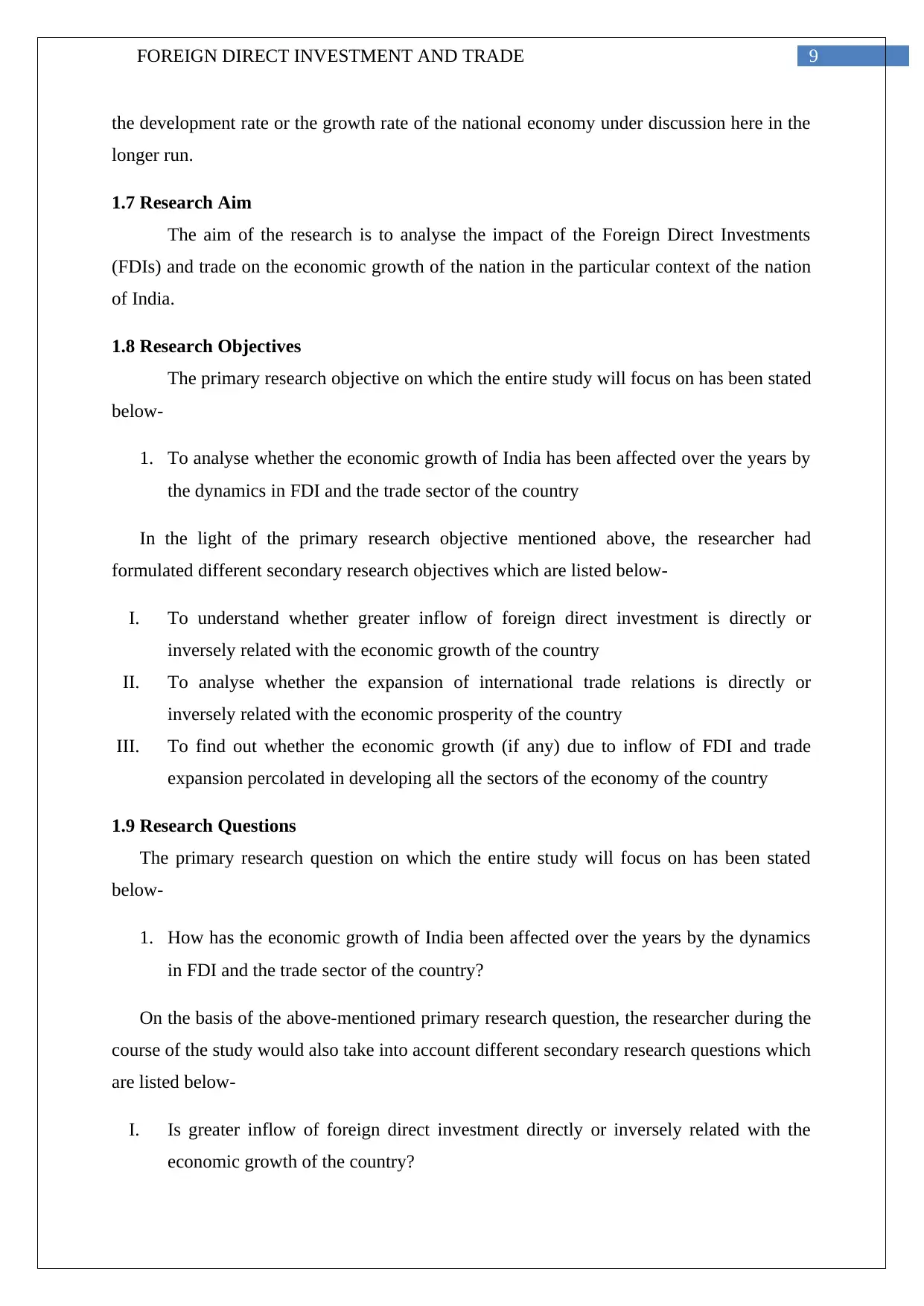
9FOREIGN DIRECT INVESTMENT AND TRADE
the development rate or the growth rate of the national economy under discussion here in the
longer run.
1.7 Research Aim
The aim of the research is to analyse the impact of the Foreign Direct Investments
(FDIs) and trade on the economic growth of the nation in the particular context of the nation
of India.
1.8 Research Objectives
The primary research objective on which the entire study will focus on has been stated
below-
1. To analyse whether the economic growth of India has been affected over the years by
the dynamics in FDI and the trade sector of the country
In the light of the primary research objective mentioned above, the researcher had
formulated different secondary research objectives which are listed below-
I. To understand whether greater inflow of foreign direct investment is directly or
inversely related with the economic growth of the country
II. To analyse whether the expansion of international trade relations is directly or
inversely related with the economic prosperity of the country
III. To find out whether the economic growth (if any) due to inflow of FDI and trade
expansion percolated in developing all the sectors of the economy of the country
1.9 Research Questions
The primary research question on which the entire study will focus on has been stated
below-
1. How has the economic growth of India been affected over the years by the dynamics
in FDI and the trade sector of the country?
On the basis of the above-mentioned primary research question, the researcher during the
course of the study would also take into account different secondary research questions which
are listed below-
I. Is greater inflow of foreign direct investment directly or inversely related with the
economic growth of the country?
the development rate or the growth rate of the national economy under discussion here in the
longer run.
1.7 Research Aim
The aim of the research is to analyse the impact of the Foreign Direct Investments
(FDIs) and trade on the economic growth of the nation in the particular context of the nation
of India.
1.8 Research Objectives
The primary research objective on which the entire study will focus on has been stated
below-
1. To analyse whether the economic growth of India has been affected over the years by
the dynamics in FDI and the trade sector of the country
In the light of the primary research objective mentioned above, the researcher had
formulated different secondary research objectives which are listed below-
I. To understand whether greater inflow of foreign direct investment is directly or
inversely related with the economic growth of the country
II. To analyse whether the expansion of international trade relations is directly or
inversely related with the economic prosperity of the country
III. To find out whether the economic growth (if any) due to inflow of FDI and trade
expansion percolated in developing all the sectors of the economy of the country
1.9 Research Questions
The primary research question on which the entire study will focus on has been stated
below-
1. How has the economic growth of India been affected over the years by the dynamics
in FDI and the trade sector of the country?
On the basis of the above-mentioned primary research question, the researcher during the
course of the study would also take into account different secondary research questions which
are listed below-
I. Is greater inflow of foreign direct investment directly or inversely related with the
economic growth of the country?
Paraphrase This Document
Need a fresh take? Get an instant paraphrase of this document with our AI Paraphraser
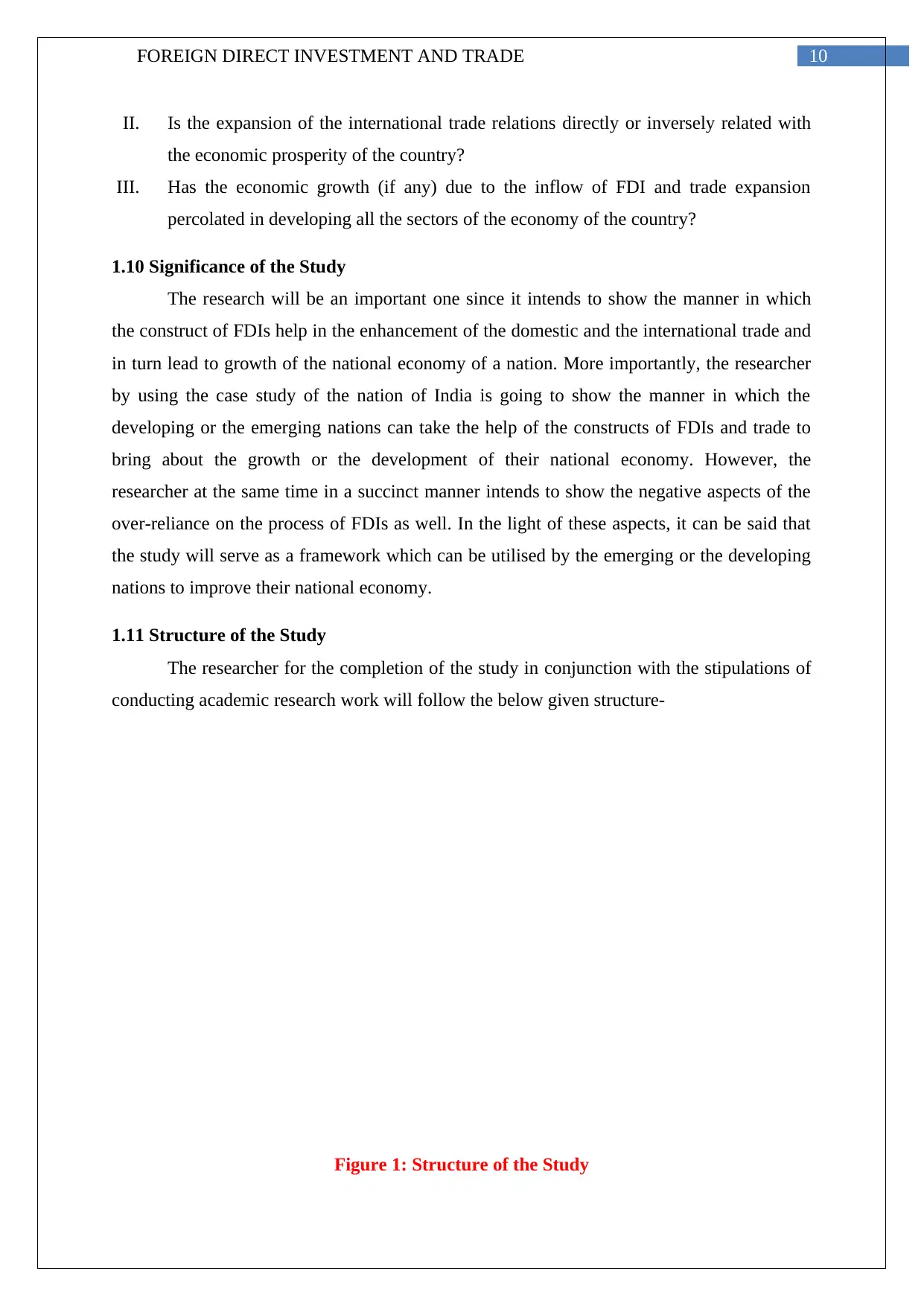
10FOREIGN DIRECT INVESTMENT AND TRADE
II. Is the expansion of the international trade relations directly or inversely related with
the economic prosperity of the country?
III. Has the economic growth (if any) due to the inflow of FDI and trade expansion
percolated in developing all the sectors of the economy of the country?
1.10 Significance of the Study
The research will be an important one since it intends to show the manner in which
the construct of FDIs help in the enhancement of the domestic and the international trade and
in turn lead to growth of the national economy of a nation. More importantly, the researcher
by using the case study of the nation of India is going to show the manner in which the
developing or the emerging nations can take the help of the constructs of FDIs and trade to
bring about the growth or the development of their national economy. However, the
researcher at the same time in a succinct manner intends to show the negative aspects of the
over-reliance on the process of FDIs as well. In the light of these aspects, it can be said that
the study will serve as a framework which can be utilised by the emerging or the developing
nations to improve their national economy.
1.11 Structure of the Study
The researcher for the completion of the study in conjunction with the stipulations of
conducting academic research work will follow the below given structure-
Figure 1: Structure of the Study
II. Is the expansion of the international trade relations directly or inversely related with
the economic prosperity of the country?
III. Has the economic growth (if any) due to the inflow of FDI and trade expansion
percolated in developing all the sectors of the economy of the country?
1.10 Significance of the Study
The research will be an important one since it intends to show the manner in which
the construct of FDIs help in the enhancement of the domestic and the international trade and
in turn lead to growth of the national economy of a nation. More importantly, the researcher
by using the case study of the nation of India is going to show the manner in which the
developing or the emerging nations can take the help of the constructs of FDIs and trade to
bring about the growth or the development of their national economy. However, the
researcher at the same time in a succinct manner intends to show the negative aspects of the
over-reliance on the process of FDIs as well. In the light of these aspects, it can be said that
the study will serve as a framework which can be utilised by the emerging or the developing
nations to improve their national economy.
1.11 Structure of the Study
The researcher for the completion of the study in conjunction with the stipulations of
conducting academic research work will follow the below given structure-
Figure 1: Structure of the Study
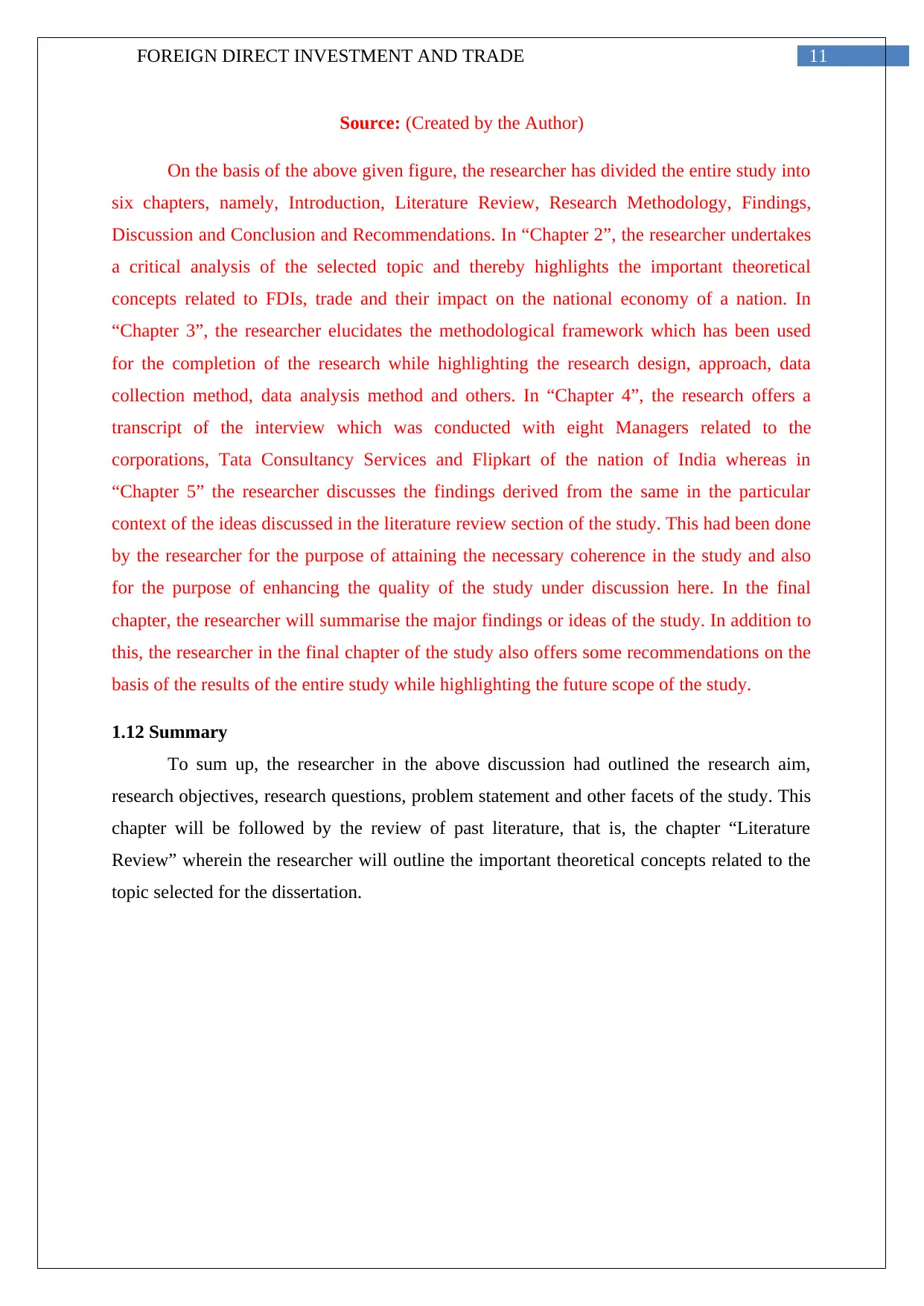
11FOREIGN DIRECT INVESTMENT AND TRADE
Source: (Created by the Author)
On the basis of the above given figure, the researcher has divided the entire study into
six chapters, namely, Introduction, Literature Review, Research Methodology, Findings,
Discussion and Conclusion and Recommendations. In “Chapter 2”, the researcher undertakes
a critical analysis of the selected topic and thereby highlights the important theoretical
concepts related to FDIs, trade and their impact on the national economy of a nation. In
“Chapter 3”, the researcher elucidates the methodological framework which has been used
for the completion of the research while highlighting the research design, approach, data
collection method, data analysis method and others. In “Chapter 4”, the research offers a
transcript of the interview which was conducted with eight Managers related to the
corporations, Tata Consultancy Services and Flipkart of the nation of India whereas in
“Chapter 5” the researcher discusses the findings derived from the same in the particular
context of the ideas discussed in the literature review section of the study. This had been done
by the researcher for the purpose of attaining the necessary coherence in the study and also
for the purpose of enhancing the quality of the study under discussion here. In the final
chapter, the researcher will summarise the major findings or ideas of the study. In addition to
this, the researcher in the final chapter of the study also offers some recommendations on the
basis of the results of the entire study while highlighting the future scope of the study.
1.12 Summary
To sum up, the researcher in the above discussion had outlined the research aim,
research objectives, research questions, problem statement and other facets of the study. This
chapter will be followed by the review of past literature, that is, the chapter “Literature
Review” wherein the researcher will outline the important theoretical concepts related to the
topic selected for the dissertation.
Source: (Created by the Author)
On the basis of the above given figure, the researcher has divided the entire study into
six chapters, namely, Introduction, Literature Review, Research Methodology, Findings,
Discussion and Conclusion and Recommendations. In “Chapter 2”, the researcher undertakes
a critical analysis of the selected topic and thereby highlights the important theoretical
concepts related to FDIs, trade and their impact on the national economy of a nation. In
“Chapter 3”, the researcher elucidates the methodological framework which has been used
for the completion of the research while highlighting the research design, approach, data
collection method, data analysis method and others. In “Chapter 4”, the research offers a
transcript of the interview which was conducted with eight Managers related to the
corporations, Tata Consultancy Services and Flipkart of the nation of India whereas in
“Chapter 5” the researcher discusses the findings derived from the same in the particular
context of the ideas discussed in the literature review section of the study. This had been done
by the researcher for the purpose of attaining the necessary coherence in the study and also
for the purpose of enhancing the quality of the study under discussion here. In the final
chapter, the researcher will summarise the major findings or ideas of the study. In addition to
this, the researcher in the final chapter of the study also offers some recommendations on the
basis of the results of the entire study while highlighting the future scope of the study.
1.12 Summary
To sum up, the researcher in the above discussion had outlined the research aim,
research objectives, research questions, problem statement and other facets of the study. This
chapter will be followed by the review of past literature, that is, the chapter “Literature
Review” wherein the researcher will outline the important theoretical concepts related to the
topic selected for the dissertation.
⊘ This is a preview!⊘
Do you want full access?
Subscribe today to unlock all pages.

Trusted by 1+ million students worldwide
1 out of 57
Related Documents
Your All-in-One AI-Powered Toolkit for Academic Success.
+13062052269
info@desklib.com
Available 24*7 on WhatsApp / Email
![[object Object]](/_next/static/media/star-bottom.7253800d.svg)
Unlock your academic potential
Copyright © 2020–2025 A2Z Services. All Rights Reserved. Developed and managed by ZUCOL.





